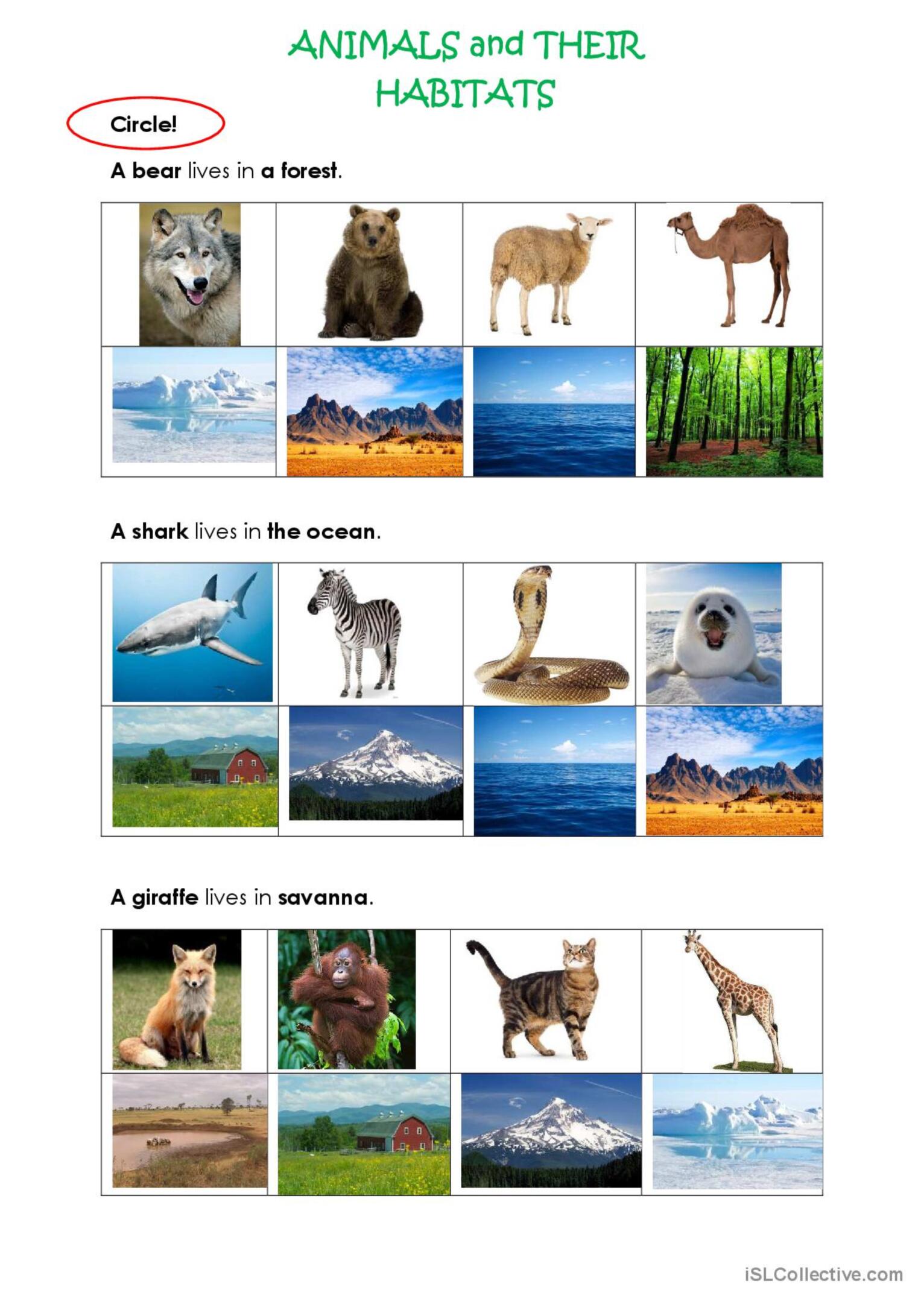The Wonder Of Animals: Their Habitats, Behaviors, And Adaptations

Table of Contents
Diverse Animal Habitats and Their Influence
Animal habitats are the environments where animals live, encompassing everything from the smallest insect's burrow to the vast expanse of the ocean. These habitats, often categorized into biomes like forests, deserts, oceans, and grasslands, profoundly influence the evolution and survival of the animals within them. Understanding these ecosystems is vital for wildlife conservation and comprehending the impact of environmental changes.
-
Forests: These biodiversity hotspots boast a complex layering of vegetation providing diverse niches for a wide range of animals. From the canopy-dwelling monkeys to the ground-dwelling insects, each species plays a unique role in the forest ecosystem. The loss of forest habitats due to deforestation significantly impacts animal populations, leading to habitat fragmentation and species decline.
-
Deserts: Characterized by extreme temperatures and scarce water, deserts present unique challenges for their inhabitants. Animals living in deserts have evolved remarkable adaptations, such as nocturnal activity to avoid intense heat and efficient water conservation mechanisms. The increasing desertification of land due to climate change further threatens the already fragile desert ecosystems and the animals that call them home.
-
Oceans: The vastness and depth of the oceans support an incredible array of marine life. From the shallow coral reefs teeming with colorful fish to the deep-sea creatures adapted to immense pressure and darkness, the ocean's biodiversity is unparalleled. Pollution and overfishing pose serious threats to marine animal habitats and populations.
-
Grasslands: These open areas, including savannas and prairies, support large herds of grazing animals and their predators. The abundance of grasses provides sustenance, but these habitats are also vulnerable to habitat loss due to agriculture and urbanization. Understanding the impact of these changes on animal populations is crucial for grassland conservation.
The impact of habitat loss and fragmentation is a major concern for wildlife conservation. As human activities encroach upon natural habitats, animals lose their homes, leading to population declines and even extinction. Protecting and restoring animal habitats is essential for maintaining biodiversity and ensuring the survival of countless species.
Fascinating Animal Behaviors and Their Evolutionary Significance
Animal behavior encompasses a vast array of actions, from simple reflexes to complex social interactions. These behaviors, shaped by natural selection, are crucial for survival and reproduction. Studying animal behavior provides insights into the evolutionary processes that have molded the animal kingdom.
-
Migration: Many animals undertake remarkable migrations, traveling vast distances between breeding and feeding grounds. The monarch butterfly's journey and the wildebeest's migration across the Serengeti are striking examples of the challenges and adaptations involved in this essential behavior.
-
Communication: Animals employ diverse communication methods, including visual displays (like peacock feathers), auditory signals (like bird songs), and chemical signals (like pheromones). These methods are crucial for attracting mates, warning of danger, and maintaining social cohesion.
-
Social Structures: Animals exhibit various social structures, ranging from solitary lifestyles to complex societies. Pack-hunting wolves, cooperative bee colonies, and elephant herds demonstrate the advantages of social living in terms of survival, reproduction, and resource access.
-
Predator-Prey Dynamics: The relationship between predators and prey drives much of the evolutionary change in both groups. The constant "arms race" between predator adaptations for hunting and prey adaptations for avoidance shapes the diversity and complexity of animal behaviors.
The Role of Instincts and Learned Behaviors
Animal behavior is a blend of innate (instinctive) and learned behaviors. Instinctive behaviors are genetically programmed, such as a newborn deer's ability to stand and walk soon after birth. Learned behaviors, on the other hand, are acquired through experience, such as a chimpanzee using a tool to extract termites from a log. The balance between these two types of behavior varies among species and plays a significant role in their adaptation and survival. Understanding the role of animal intelligence and learning is crucial for comprehending their complex behaviors.
Remarkable Animal Adaptations for Survival
Animals have evolved a remarkable array of adaptations to thrive in their diverse environments. These adaptations can be categorized into physiological, behavioral, and structural features.
-
Camouflage: Many animals have evolved camouflage to blend seamlessly with their surroundings. This adaptation helps them avoid predators or ambush prey, increasing their chances of survival. Examples include the chameleon's color-changing abilities and the stick insect's remarkable resemblance to twigs.
-
Mimicry: Some animals mimic other species for protection or predation. Viceroy butterflies mimicking the poisonous monarch butterfly are a classic example of Batesian mimicry. Müllerian mimicry involves multiple poisonous species evolving similar warning signals.
-
Physiological Adaptations: These adaptations involve internal bodily functions. Camels store water in their humps, polar bears have thick blubber for insulation, and certain animals hibernate to survive harsh winters.
-
Behavioral Adaptations: These adaptations are learned or instinctive behaviors that enhance survival. Examples include migration, tool use, and complex social behaviors that improve foraging efficiency or defense against predators.
The study of animal adaptations provides profound insights into the power of natural selection and the remarkable diversity of life on Earth. These adaptations are often finely tuned to specific environmental pressures, demonstrating the intricate relationship between animals and their habitats.
Conclusion
The study of animal habitats, behaviors, and adaptations reveals the incredible diversity and resilience of life on Earth. Understanding these aspects is not only fascinating but also crucial for effective wildlife conservation and the preservation of biodiversity. By appreciating the wonder of animals and their unique characteristics, we can better protect them and their fragile ecosystems. Continue exploring the fascinating world of animal habitats, behaviors, and adaptations—their survival depends on our understanding and action!

Featured Posts
-
 Madridskiy Turnir Sobolenko V Tsentre Skandala
May 13, 2025
Madridskiy Turnir Sobolenko V Tsentre Skandala
May 13, 2025 -
 How To Watch Texas Rangers Games In 2025 Schedule Broadcast Info Blackouts And National Tv
May 13, 2025
How To Watch Texas Rangers Games In 2025 Schedule Broadcast Info Blackouts And National Tv
May 13, 2025 -
 Porsche Grand Prix Final Sabalenka To Face Ostapenko
May 13, 2025
Porsche Grand Prix Final Sabalenka To Face Ostapenko
May 13, 2025 -
 Extreme Heat Emergency Record Temperatures In Los Angeles And Orange Counties
May 13, 2025
Extreme Heat Emergency Record Temperatures In Los Angeles And Orange Counties
May 13, 2025 -
 Serie A Odigos Gia Metadoseis Agonon
May 13, 2025
Serie A Odigos Gia Metadoseis Agonon
May 13, 2025
